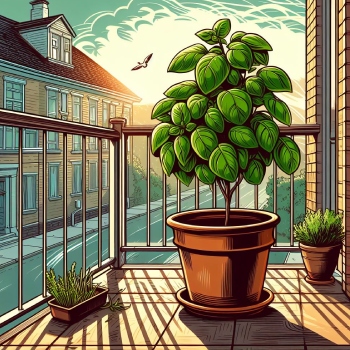Can you grow basil outside on a balcony in the UK?

Basil: the superstar of the herb world, bringing a burst of flavour to dishes across the globe. But why relegate it to the shopping list when you can have it at arm's reach on your very own balcony?
Picture this: a tiny oasis amidst the urban hustle, where you can pluck fresh basil leaves whenever the mood strikes. Sounds dreamy, right? In this article, we're breaking free from the confines of traditional gardening norms to explore the wild world of balcony basil in the UK.
Forget what you think you know about outdoor herb gardening – we're about to shake things up and prove that with a bit of creativity and determination, anyone can grow basil in even the most unlikely spaces. Ready to revolutionise your balcony with a bounty of basil? Let's dive in.
Advice from the experts 👩🌾
Think vertically! Hang small pots of basil from your balcony railing or install a vertical garden on a sunny wall. This not only maximizes space but also ensures ample sunlight exposure for your basil plants, leading to healthier growth and bountiful harvests.
How to grow basil outdoors
Basil thrives indoors, especially on warm kitchen windowsills - but it is possible to keep them outdoors, too. It's best to grow them inside, however, before moving them outside when they're bigger and stronger. Check out our guide to growing basil indoors for some background before we carry on.
Once your basil plant is healthy and ready for the great outdoors, you can move it from the safety of you indoor herb garden - but you'll then need to keep on top of a whole range of factors in the open air.
Weather, sunlight, and exposure
Alright, let's talk about getting your basil out on the balcony! So, when you're planning to move your basil outdoors, keep an eye on the weather. Wind can be a bit of a bully, drying out your plants faster than you can say "basil pesto." And frost? Well, that's like a cold snap surprise party you definitely don't want your basil to attend. Aim to move your basil outside when frosty nights are behind you, usually in late spring.
Once it's out there, make sure it's getting enough sunlight but also find a cosy spot sheltered from strong winds. And come autumn, consider bringing it back in or covering it up to extend the growing fun.
Pots and containers
Now, let's talk pots! Balcony gardening is all about making the most of your space, so containers are your best buddies. Go for pots that drain well, nobody likes soggy feet, especially not basil!
Consider size too. Pots that are 20-30 centimeters (8-12 inches) in diameter and 20-25 centimeters (8-10 inches) in depth provides enough room for singular basil plants to develop a healthy root system and to spread out comfortably. Larger containers, such as those with a diameter of 30-45 centimeters (12-18 inches) and a depth of 30-45 centimeters (12-18 inches), can accommodate multiple plants.
And hey, don't forget about style - pick containers that match your balcony vibe to really spruce things up!
Soil
Alright, soil talk! Basil's gotta have good soil to thrive, just like we all need a comfy bed to sleep in. Make sure you're using a potting mix that's fluffy and full of nutrients. Mix in some compost for that extra oomph in fertility and water retention. And remember, basil loves its nutrients, so don't forget to feed it regularly with some plant food (like Miracle-Gro All Purpose Water Soluble Plant Food) to keep it happy and growing strong!
Watering
Last but definitely not least, watering! Think of watering your basil like giving it a big, refreshing pick-me-up on a hot day. But don't drown it - waterlogged roots could be a killer! Stick your finger in the soil, and if it feels dry about an inch down, it's time to water. Give it a good soak, making sure the water reaches all the way down to the roots. And if you're forgetful (no judgment here!), consider setting up a drip irrigation system or using self-watering pots to keep your basil hydrated and thriving, even when life gets busy.
When it comes to rain and balcony gardening, it's a bit of a balancing act. While basil enjoys a good drink, too much water can spell trouble, especially in containers where drainage might not be as efficient as in the ground. If your balcony gets a lot of rain, you might want to consider moving your basil pots to a sheltered spot to prevent waterlogging. Alternatively, you can elevate your pots slightly to improve drainage or use saucers to catch excess water and prevent it from pooling around the roots.

Best basil varities for growing on a balcony
There are a huge range of basil varities, which differences in appearance, taste - and suitability for ourdoor growing. Make sure you get the right type to avoid disappointment.
| Variety | Description | Outdoor growing |
|---|---|---|
| Sweet Genovese | Sweet Genovese basil features large, bright green leaves and a classic sweet basil flavor with hints of clove and pepper. It's perfect for making pesto, salads, and pasta dishes. | Well-suited for outdoor growing in containers on a sunny balcony, but may need protection from strong winds and frost. |
| Thai Basil | Thai basil has smaller, slightly serrated leaves and a distinct spicy, licorice-like flavor with hints of anise. It's a staple ingredient in Thai and Vietnamese cuisine, lending its unique flavor to curries, stir-fries, and salads. | Can be grown outdoors in containers on a balcony during the warmer months, but may benefit from being brought indoors during cooler periods. |
| Lemon Basil | Lemon basil boasts glossy green leaves and a refreshing citrusy aroma and flavor reminiscent of lemon zest. It's ideal for adding a bright, tangy twist to salads, seafood dishes, and desserts. | Best suited for outdoor growing in containers on a sunny balcony, as it thrives in warm, sunny conditions. Protect from excessive rain and frost. |
| Red Rubin | Red Rubin basil showcases striking purple-red leaves and a slightly spicy, clove-like flavor. Its vibrant color makes it a beautiful garnish for salads, soups, and pasta dishes. | Can be grown outdoors in containers on a balcony, but may require protection from strong winds and frost. Thrives in full sunlight. |
| Genovese Compact | Genovese Compact basil is a dwarf variety with small, dense leaves and a classic sweet basil flavor. It's perfect for small spaces and container gardening, ideal for adding fresh flavor to pizzas, sandwiches, and sauces. | Excellent for balcony gardening in containers, as its compact size makes it suitable for smaller spaces. Ensure it receives adequate sunlight and protection from harsh weather conditions. |
| Cinnamon Basil | Cinnamon basil features narrow, pointed leaves and a warm, spicy aroma reminiscent of cinnamon. Its unique flavor profile makes it a delightful addition to fruit salads, desserts, and herbal teas. | Can be grown outdoors in containers on a balcony during the warmer months, but may require protection from cool temperatures and excessive rain. Thrives in full sunlight. |
| Italian Large Leaf | Italian Large Leaf basil, as the name suggests, has large, tender leaves with a sweet, mild flavor. It's perfect for making caprese salads, bruschetta, and marinara sauce. | Well-suited for outdoor growing in containers on a sunny balcony, but may need protection from strong winds and frost. Ensure it receives ample sunlight for optimal growth. |
| Spicy Globe | Spicy Globe basil forms compact, rounded mounds of small, spicy leaves with a strong basil flavor. It's great for edging garden beds, garnishing dishes, and adding a punch of flavor to salads and sauces. | Ideal for balcony gardening in containers, as its compact growth habit makes it suitable for smaller spaces. Ensure it receives sufficient sunlight and protection from harsh weather conditions. |

Outdoor basil pests
Away from the safety (and cleanliness!) of your kitchen herb garden, a basil plant can come up against some scary pests in the great outdoors.
Here's a list of some common basil baddies, and how you can deal with them.
Aphids
These tiny, sap-sucking insects can quickly infest basil plants, causing leaves to curl and yellow. Keep an eye out for clusters of aphids on the undersides of leaves, and use insecticidal soap or a strong blast of water to knock them off.
Whiteflies
Whiteflies are another sap-sucking pest that can weaken basil plants and spread disease. Look for white, moth-like insects fluttering around your plants and sticky honeydew residue on leaves. Neem oil or insecticidal soap can help control whitefly populations.
Spider mites
These minuscule arachnids can wreak havoc on basil plants, sucking the juices from leaves and causing them to yellow and wilt. Spider mites often leave behind fine webbing on the undersides of leaves. Regularly spraying your basil with water can help deter spider mites, and insecticidal soap can be used for severe infestations.
Slugs and snails
These slimy critters love to munch on basil leaves, leaving behind ragged edges and holes. To keep them at bay, create barriers with copper tape around your pots or use organic slug pellets. You can also encourage natural predators like frogs and birds to visit your balcony garden.
Caterpillars
Certain caterpillar species, such as cabbage loopers and tomato hornworms, may occasionally feast on basil leaves. Handpick caterpillars from your plants and relocate them elsewhere. Alternatively, you can use Bacillus thuringiensis (Bt), a natural bacterial insecticide, to control caterpillar populations.
Fungal diseases
While not technically pests, fungal diseases like powdery mildew and downy mildew can still wreak havoc on basil plants, especially in humid conditions. Ensure good air circulation around your plants, avoid overhead watering, and remove any infected leaves promptly to prevent the spread of disease.
By staying vigilant and taking proactive measures to control pests, you can help your balcony basil thrive and keep those unwanted visitors at bay.

And that's that! For more tips and tricks for growing herbs inside and outdoors, check out some more articles below.
Happy gardening! 🪴
